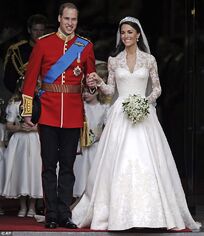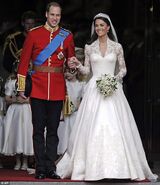|
Wedding dress of Kate Middleton | |
| Designer |
Sarah Burton, designer Royal School of Needlework |
|---|---|
| Year | 2011 |
| Type | lace applique bodice |
Pre-wedding speculation[]
Before the day, there was much speculation as to what Catherine Middleton would choose for her dress. On 6 March, The Sunday Times reported on speculation that Middleton had chosen McQueen designer Sarah Burton. Their report stated: "A fashion source said that the dress will be a combination of Middleton's own design ideas and Burton's deep knowledge and understanding of high fashion." The label and Burton both denied any involvement. Burton's work came to the notice of Middleton in 2005 when she attended the wedding of Tom Parker Bowles, the son of the Duchess of Cornwall. Burton had designed the bridal gown for his bride, fashion journalist Sara Buys. Also suggested were Victoria Beckham, Sophie Cranston's Libelula, Jasper Conran, Elizabeth Emanuel, Daniella Issa Helayel, Marchesa by Keren Craig and Georgina Chapman, Stella McCartney, Bruce Oldfield, and Catherine Walker.
Burton emerged as the odds-on favourite to create the dress amongst bookmakers, so much so that the English bookmaker William Hill stopped taking wagers weeks before the event. David Emanuel, co-designer of Princess Diana's wedding dress, commented to the Canadian fashion journalist Jeanne Beker that "McQueen is owned by Gucci, an Italian company. If Kate's gone that route, it would be the first time a British-owned house wasn't chosen. And the Italians would have a field day with that."
According to Joanna Marschner, Senior Curator of the Historic Royal Palaces, "the dresses have had to grow as the media expectation has grown. Television cameras in Westminster Abbey have meant that those dresses are going to have to live up to those venues and indeed be of a design excellence to bear infinite scrutiny."
Design[]
It has a lace applique bodice with detailing symbolising the nations of the United Kingdom. It was made of satin and featured a lace applique bodice and skirt. The lace bodice design was hand-made using a technique that originated in Ireland in the 1820s called Carrickmacross, which involved cutting out rose detailing (symbolising England), thistles (Scotland), daffodils (Wales), and shamrocks (Ireland), individually applying them to the ivory silk tulle. These lace appliques were hand-made by the Royal School of Needlework, based at Hampton Court Palace. The dressmakers used fresh needles every three hours, and washed their hands every half an hour to avoid marking the fabric.
The bridal train measured 270 cm (110 in). Hand-cut English lace and French Chantilly lace was used throughout the bodice, skirt, and the underskirt trim. With laces coming from different sources, much care was taken to ensure that each flower was the same colour. The whole process was overseen and put together by hand by Ms Burton and her team. The "ivory satin bodice is padded slightly at the hips and narrowed at the waist, and was inspired by the Victorian tradition of corsetry that is a particular Alexander McQueen hallmark. On the back are 58 buttons of gazar and organza, which fasten by means of Rouleau loops. The underskirt is made of English Cluny lace over silk tulle."
The main body of the dress was made in ivory and white satin gazar, using UK fabrics which had been specially sourced by Sarah Burton, with a long, full skirt designed to echo an opening flower, with soft pleats which unfolded to the floor, forming a Victorian-style semi-bustle at the back, and finishing in a short train measuring just under three metres in length.
To partially fulfill the "something blue" portion of the British wedding tradition, a blue ribbon was sewn inside the dress. The design for the bodice of the dress featuring Carrickmacross craftsmanship was the "something old".
The British tabloid The News of the World reported that to maintain secrecy, the embroiderers at the Royal School of Needlework were initially told that the dress was intended to be used in a television costume drama and that cost was no object. As a result, it had been widely reported that the dress cost £250,000, although a Clarence House spokesperson dismissed that claim.
Reception and influence[]
The dress generated much comment in the media from fashion experts and was very well received. It was noted that the design was largely traditional and inspired by dresses from the 1950s. Karl Lagerfeld wrote "the dress is classic and goes very well in the Westminster decor. It almost reminds me of Elizabeth's wedding, the royal weddings in the [19]50s. The proportion of the train is good. The lace is very pretty. I like the veil a lot."Antonio Marras, of Kenzo, stated, "the choice of the label and the style of the dress was a very clever mix between edgy fashion and tradition — all in a very British way. You could see references to Grace Kelly or Queen Elizabeth's dresses, but in a simpler, more modern way." It was noted that the lace bodice of Middleton's dress echoed that worn by Grace Kelly for her marriage to Rainier III, Prince of Monaco in 1956.Comparisons were also drawn with Princess Margaret's wedding dress. Mark Badgley of Badgley Mischka wrote that "it's the kind of gown that will stand the test of time. Not all gowns do. Any bride across the world will want to wear it. It's got a touch of vintage, a classic 1950s ball gown, so timeless that her daughter would look gorgeous in this gown 30 years from now." Meanwhile Oscar de la Renta stated that it was "a very traditional dress for a very traditional wedding...not ostentatious. There was not 50 meters of train, and it was not overembroidered. It was just a very traditional dress for a ravishing girl who doesn't need a lot."
Comparisons were also made to the dress worn by Prince William's mother, Diana, Princess of Wales. Vera Wang said "Diana's dress had a sense of innocence, whimsy, almost storybook romance. In contrast Catherine's gown was about way more than simply the dress. Sarah Burton channelled a new take on classicism for a modern-day bride who will one day be queen." Diana's wedding dress maker, Elizabeth Emanuel, has suggested: "Exactly as it happened in 1981, there are going to be people watching as she walks down the aisle with their sketch pads, with the machinists and pattern cutters all ready and waiting. By the next morning you'll see copies in High Street." Emanuel says the dress would fit many body shapes. Chinese replica of the dress offered for sale to the public four weeks after the Royal Wedding.There were many suggestions that the style of the dress would influence wedding fashion for the next few years. Alison McGill, the editor-in-chief of Weddingbells Magazine: "I think her choice to wear long sleeves signals a big goodbye to strapless wedding gowns." Meanwhile Veronica Di Santo-Abramowicz, of the Toronto-based Ines Di Santo label opined "Kate's dress will influence so much of the bridal style that we will see over the next few years. It always happens that when a person of royalty or high stature gets married, this sets trends for several years. For example, Princess Diana's gown and Carolyn Bessette's gown are two noteworthy brides that come to mind."
One British firm's replica, commissioned by The Times as a contest prize, was completed less than five hours after Middleton began her car ride to the Abbey. The firm received numerous inquiries within a day, but expressed that it would have to consult lawyers before replicas could be sold. New Zealand couturist Jane Yeh worked through the night after the wedding to create another copy of the dress. Chinese dressmakers told news reporters they expected to have knock-offs of the dress available one week from the event; one expressed frustration that it was not leaked in advance so that they could have stock prepared earlier. Another suggested a £70 to £90 retail price.
The choice of a dress from the fashion house of Alexander McQueen, who had committed suicide in 2010, led Hubert de Givenchy to state "It's a lovely thought, a nice tribute."
The dress along with other items pertaining to the Royal Wedding will be exhibited at Buckingham Palace from 23 July 2011 until 3 October, 2011. The method of displaying the dress and tiara (on a headless mannequin lit by white lighting) was reported to have been described as "horrible" by the Queen during a private tour of the exhibition with the Duchess of Cambridge in July 2011. A microphone overheard the Queen remarking to the Duchess "It's made to look very creepy" while Catherine responded that it had a "3D effect".
The dress helped attract a record number of visitors to Buckingham Palace in the summer months of 2011.It was also reported to have helped raise around eight million pounds towards Kate Middleton’s own charity fund as well as palace renovations.





